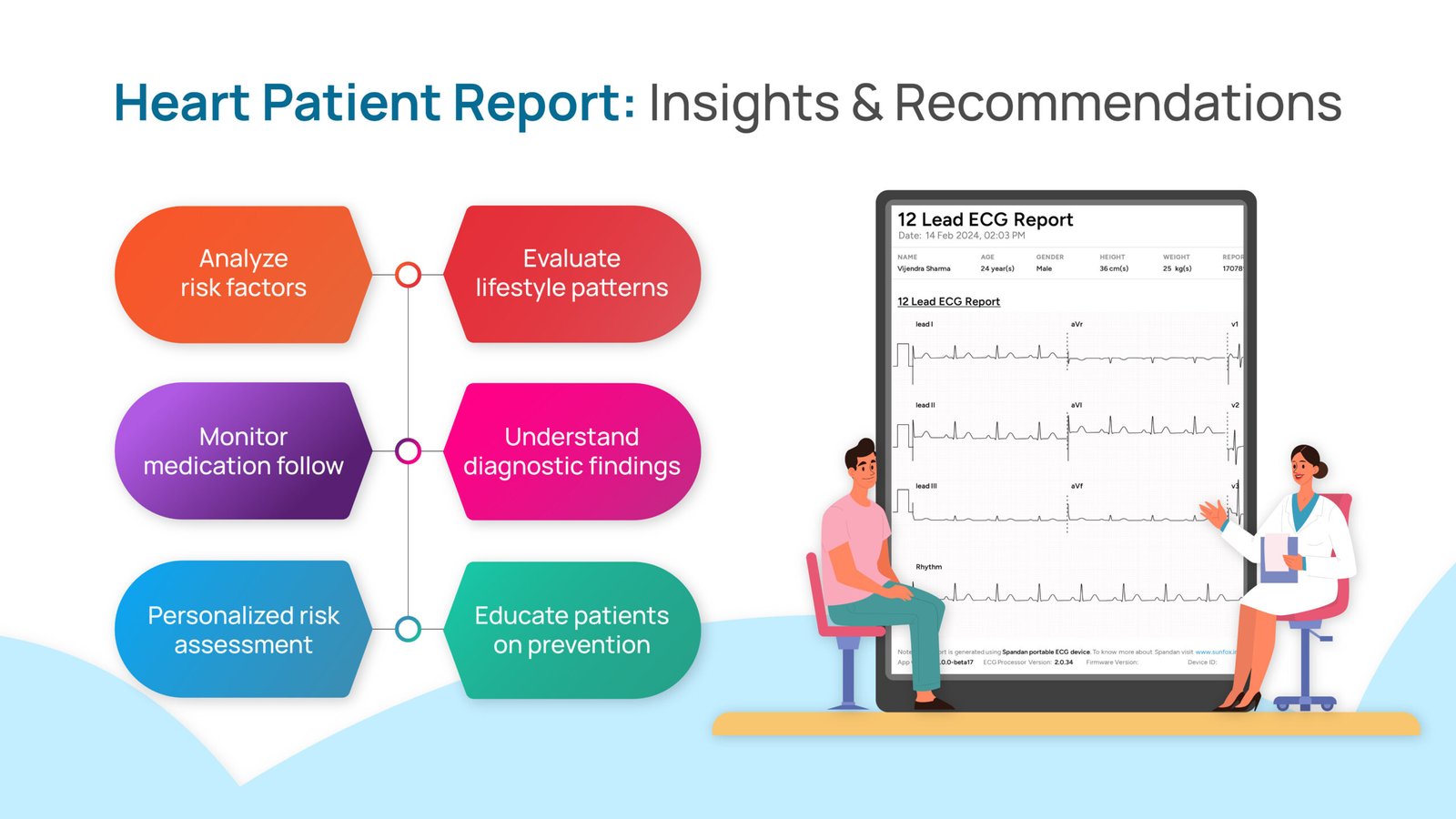
Author:- Mr. Ritesh Sharma
One of the leading causes of mortality worldwide still remains heart disease. Hence, the insights gained from a heart patient report become extremely crucial in determining the treatment method and prevention techniques for the patient. The intricacies of heart patient reports are difficult to understand, but also important for the aforementioned reasons. The heart patient report is generated through varied tests ranging from blood tests to stress tests and screenings like ECGs and Echocardiograms.
In this blog, we will discuss all the key aspects of a heart patient report and uncover all the key details. Furthermore, we will also provide you with insights and recommendations for improving your cardiovascular health.
Heart Patient Report Insights
The heart patient report gives various insights to healthcare professionals into the cardiovascular health of the patient. These insights include risk factor analysis, diagnostic findings, lifestyle and behavioral patterns, etc. Let’s dive deeper into these insights and try to understand them in a more refined manner.
Risk Factor Analysis:
- A heart patient report underlines the various risk factors associated with heart diseases, such as hypertension, high cholesterol levels, diabetes, obesity, smoking, sedentary lifestyle, and genetic predispositions.
- Once you analyze these risk factors, you get valuable insights into the patient’s overall cardiovascular health and you can opt for the relevant treatment method.
Diagnostic Findings:
- Through diagnostic tests, such as ECGs, echocardiograms, stress tests, and coronary angiograms, we get to know the structural and functional aspects of the heart. These aspects help us determine the right treatment method for the patient.
- These reports may also reveal cardiac conditions, such as cardiac arrhythmias of different arrhythmia classifications, coronary artery diseases, heart valve abnormalities, myocardial infarction, or heart failure. This further guides healthcare professionals in deciding the treatment approach for the cardiac condition.
Medication Adherence and Response:
- It is important to monitor the medication adherence and response for the swift improvement of the patient. Through the heart patient report, healthcare professionals get valuable insights into medication adherence and response to the patient’s body.
- By understanding how patients respond to the medication enables healthcare professionals to decide on further treatment strategies and medication for them.
Lifestyle and Behavioral Patterns:
- Through the heart patient report, healthcare professionals get insights into the lifestyle and behavioral patterns that influence the heart health of the patients. These include dietary habits, physical activity levels, stress management practices, and substance use.
- In addition, healthcare professionals also identify unhealthy behaviors in patients and opt for targeted interventions. These interventions include alterations in diet patterns, exercise regimens, stress reduction techniques, and smoking cessation programs.
Recommendations for Better Cardiovascular Health
For better cardiovascular health, the following is a list of all the recommendations. These recommendations vary from individual to individual based on their heart patient report.
Personalized Risk Assessment:
- To find out the predisposing factors for heart disease, you must conduct a comprehensive personalized risk assessment for individuals. This involves evaluating family history, lifestyle factors, and clinical parameters.
- By evaluating these risk factors, you can adopt treatment strategies tailored to individuals based on their family history of disease and various lifestyle factors.
Patient Education and Empowerment:
- You must empower patients about the risk factors associated with heart disease and tell them about preventive measures. Furthermore, you must make them aware of the importance of medication adherence, lifestyle changes, and follow-up checkups after obtaining the heart patient report.
- There must be a mutual understanding between healthcare professionals and patients which encourages participation in self-care and decision-making processes.
Holistic Lifestyle Interventions:
- You must promote holistic lifestyle interventions, such as healthy eating, regular physical activity, stress management, adequate sleep, and smoking cessation.
- Encourage the patient to consume a plant-based diet, rich in fruits, vegetables, whole grains, and lean proteins. Furthermore, ask them to limit their intake of trans and saturated fats.
Regular Monitoring and Follow-up:
- You must implement regular monitoring of your heart health. For this, you can use portable ECG devices. Moreover, there should also be follow-up tests in your routine after you have been cured. This will ensure that you steer clear of cardiovascular disease in the future.
- You can also utilize technology-based innovations, such as telemedicine, wearable devices, etc for your regular and follow-up check-ups.
Multidisciplinary Care Coordination:
- We must be committed to fostering multidisciplinary care coordination. For this, there must be collaboration among multidisciplinary healthcare teams, including cardiologists, primary care physicians, nurses, dietitians, exercise physiologists, and mental health professionals.
- If your loved one is a heart patient then you must take utmost care of him/ her not only by medication but also with empathy and warmth. Spend more time with them and make them feel loved. Engage with them in various activities that contribute to their well-being and speedy recovery.
In conclusion, the heart patient report gives various insights into the heart health of the patients. Through this report, healthcare professionals can adopt various treatment methods for patients and prevent them from further harm. These reports give patients insights into their heart abnormalities, whether it is heart palpitations or myocardial infarctions (heart attacks). Various tests generate these reports based on the type of abnormalities the patient is affected by.
However, the most common tests that generate heart patient reports are ECGs, echocardiograms, several blood tests, etc. All these tests are non-invasive and can be recurring for the patient. Hence, they must take care of their cardiovascular health with continuous checkups and follow-ups.
Empowering patients with knowledge, fostering lifestyle modifications, promoting regular monitoring, and facilitating multidisciplinary care coordination are essential pillars in the quest for optimal cardiovascular health. Let’s prioritize proactive measures to safeguard heart health and enhance overall well-being for individuals worldwide.



